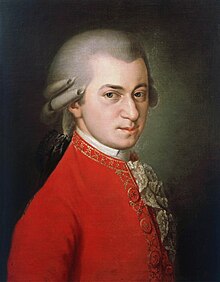

4 – Allegro spiritoso,
4
2. Andante con moto,
8
3. Menuetto,
4
4. Finale (Presto),
4 Performed by the Tsumugi Orchestra conducted by Takashi Inoue (2013)
Problems playing these files? See media help.
The Symphony No. 36 in C major, K. 425, also known as the Linz Symphony, was written by Wolfgang Amadeus Mozart during a stopover in the Austrian town of Linz on his and his wife's way back home to Vienna from Salzburg in late 1783. The entire symphony was written in four days to accommodate the local count's announcement, upon hearing of the Mozarts' arrival in Linz, of a concert. The première in Linz took place on 4 November 1783. The composition was also premièred in Vienna on 1 April 1784. The autograph score of the "Linz Symphony" was not preserved, but a set of parts sold by Mozart to the Fürstenberg court at Donaueschingen in 1786 does survive.
Structure
The symphony is scored for 2 oboes, 2 bassoons, 2 horns, 2 trumpets, timpani and strings.
There are 4 movements:
Every movement except the minuet is in sonata form.
The first movement briefly quotes the famous Hallelujah Chorus from Handel's Messiah in the exposition.
The slow movement has a siciliano character and meter which was rare in Mozart's earlier symphonies (only used in one of the slow movements of the "Paris") but would appear frequently in later works such as No. 38 and No. 40.
The next symphony by Mozart is Symphony No. 38. The work known as "Symphony No. 37" is mostly by Michael Haydn.
Notes
- ^ Mozart, Wolfgang Amadeus (2005). Die Sinfonien IV. Translated by Robinson, J. Branford. Kassel: Bärenreiter-Verlag. p. XVII. ISMN M-006-20466-3
- Eisen, Cliff (1988). "New Light on Mozart's 'Linz' Symphony, K.425". Journal of the Royal Musical Association. 113 (1): 81–96. doi:10.1093/jrma/113.1.81. JSTOR 766270.
- Brown, A. Peter, The Symphonic Repertoire (Volume 2). Indiana University Press (ISBN 025333487X), pp. 401–406 (2002).
- Perger, Lothar (1907). Thematisches Verzeichnis der Instrumentalwerke von Michael Haydn. Vienna: Artaria.
Further reading
- Steinberg, Michael. "The Symphony: A Listeners Guide". p. 153. Oxford University Press, 1995.
External links
- Sinfonie in C KV 425: Score and critical report (in German) in the Neue Mozart-Ausgabe
- Symphony No. 36 (W. A. Mozart): Scores at the International Music Score Library Project
| Wolfgang Amadeus Mozart | |||
|---|---|---|---|
| Biography | |||
| Music |
| ||
| Family |
| ||
| Influences | |||
| Related | |||
This article about a symphony is a stub. You can help Misplaced Pages by expanding it. |
